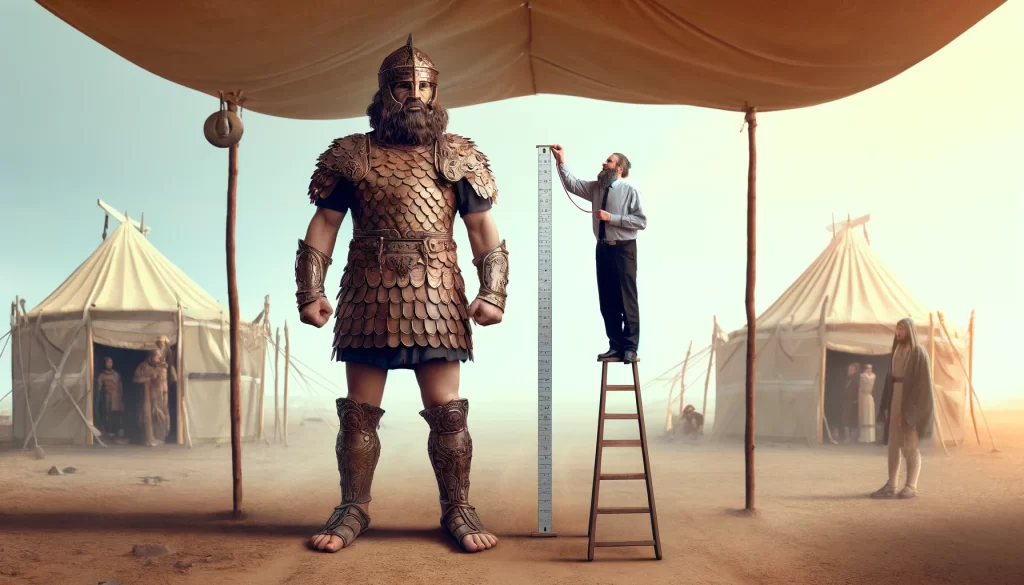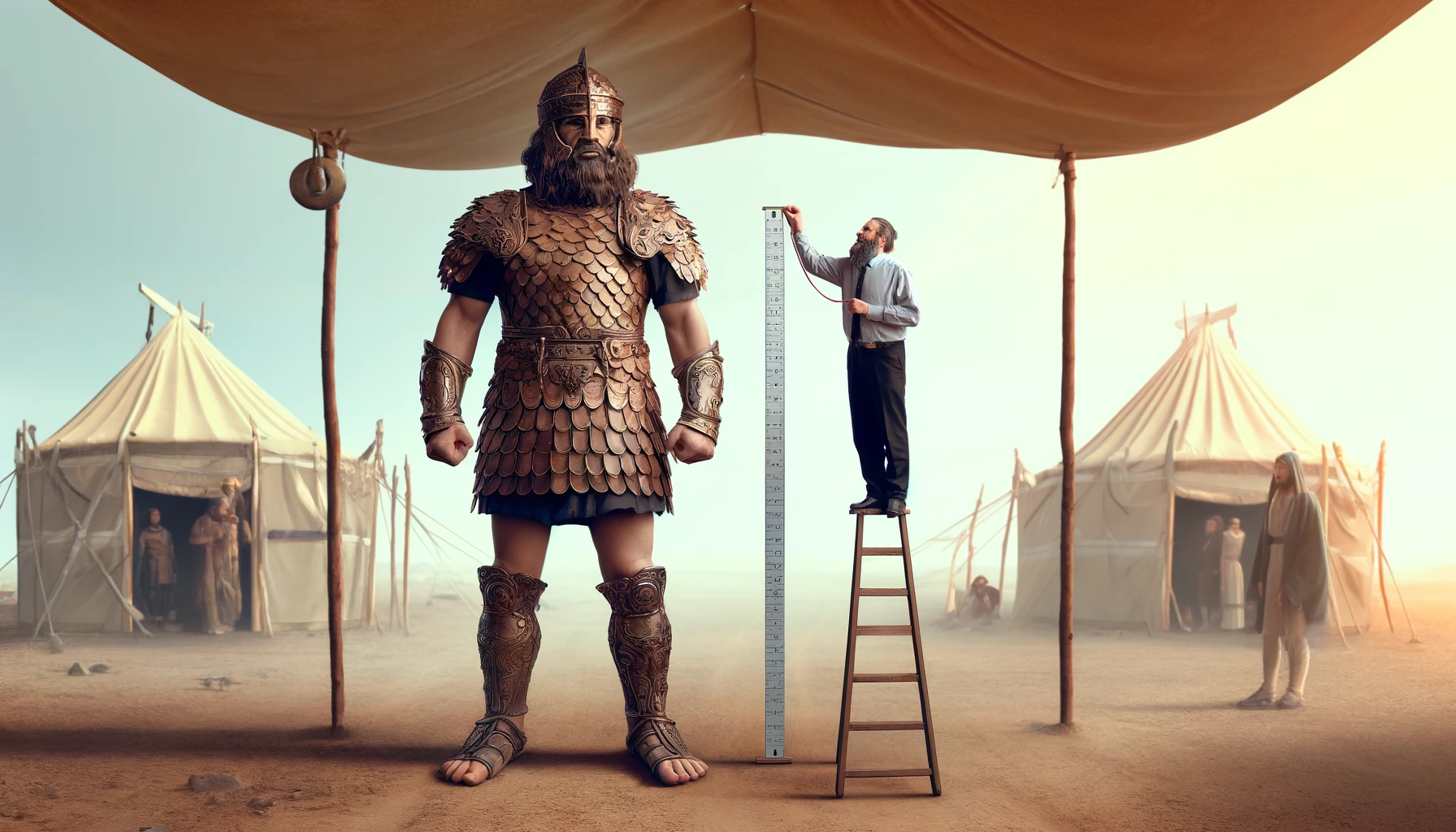
We’ve been discussing the puzzle of David’s assault on Goliath, whether David hit Goliath in the head or the leg, given that the Hebrew terms for forehead and grieve are identical.[1] We’ve looked at the nature of slings and sling stones (To which we will shortly return).
Some have suggested that Goliath’s face plant, in spite of being hit with a 150 mph, nearly one pound rock that sank into his forehead, was the result of his gigantic status. He was just too big and too heavy to topple.
What many do not know, is that Goliath’s size is also at issue… not by some liberal scholars downing whiskey sours in seedy bars while cursing Scripture, but by Scripture itself.
Commentators frequently employ the term “giant” to describe Goliath, a label imagined to leave him impervious to assaults that would bring down a merely big man. Thus, they evaluate Ariella Deem’s 1978 proposal that David struck Goliath in a grieve by their own imagination’s vision of this reality. The Hebrew text has, after all, described Goliath as six cubits and a span, or, by traditional scholarly presentations of cubit measures,[2] 9′ 9″ tall, a reading that is supported by both Symmachus (Early Greek Text around AD 200) and Origen (AD 185-254ish), and championed by Jerome (AD 347-420).
This would, of course make Goliath about ten inches taller than the tallest recorded man in modern times; Robert Pershing Waldow was 8′ 11″. Goliath would be 1′ 7″ taller than the tallest living man; Sultan Kosen stands 8′ 2″.[3] The tallest basketball player in NBA history, Manut Bol, rises to a mere 7′ 7″—a full 2′ 2″ shorter than the Hebrew MT text’s vision of Goliath.[4]
Such modernly verifiable heights are often caused by, or result in serious medical problems. Far from being warriors, those, thus afflicted, tend to live enfeebled lives and to die young.[5]
Considering the rendering of both the LXX (Greek Old Testament from around 200 BC) and a Hebrew Qumran Samuel Scroll, however, this mental picture needs to at least open itself to the possibility that Goliath, while a truly large and intimidating warrior, may not be properly classed as a “giant” with all that that term conjures in the modern imagination. Both the LXX and Qumran scroll (4QSam) place Goliath’s height at four cubits and a span, approximately 6′ 9″ tall.
Does this diminish his awesomeness as an enemy? Given how enfeebled the bigger giants are, I think not. Neither does Josephus (AD 37-100) who writes of him, “…a man of vast bulk, for he was of four cubits and a span in tallness, and had about him weapons suitable to the largeness of his body, for he had a breastplate on that weighed five thousand shekels: he had also a helmet and greaves of brass, as large as you would naturally suppose might cover the limbs of so vast a body.” [6] Given the evidence proposed for a standard 5′ 3″ male height among the Semites of that age,[7] David, who, unlike Saul, was never deemed a man of great stature, still faced a fearsome foe, indeed.
Some will again accuse me of trying to diminish the miraculousness of the event, but I am not. I am trying to understand the event without embellishment, which never serves the purposes of God in the end.
If I were wrestling with a text that said someone either jumped from a 20′ roof to the ground, or from the ground to a 20′ roof, either being possible grammatically in the text, I do not do anyone a favor by assuming “the most miraculous version,” even in Scripture.
I’ll let the footnotes get technical; but let me just say here, that the textual evidence for a 4 cubit reading is mucho strong.[8]
Clyde E. Billington, challenges the growing confidence in the Greek reading by asserting, among other things,[9] that:
- Goliath’s 125lbs armor is too heavy for a 6′ 9″ man.
- To this, J. D. Hays calls for a re-imagining informed by known height and strength issues in modern military, medical, and athletic endeavors, such as the fact that normal sized Marines are known to carry weights equal to that purported for Goliath’s armor.[10] One might also note that average sized Greek Hoplite warriors of old (5′ 10″) were know to carry as much as 100 lbs of armor while running up to a mile before hitting the battle lines. Goliath’s armor is a mere 25% increase, not the astronomical multiplication one might expect from a human monster.
- He insists that Greeks from Egypt would surely have converted the numbers (6 cubits to 4 cubits) to communicate the proper height when transmitting Hebrew cubits into much longer Royal Egyptian cubits… which makes sense, save for…
- J. D. Hays’ insistence that Billington’s criticism ignores the fact that one finds 4 cubits in the Hebrew language Qumran scroll (4QSam). His suggestion also defies the known history of the LXX in Samuel-Kings.[11]
One might add to this the observation that little 5′ 0″-5’5″ David makes ready use of Goliath’s sword when going into battle following his flight from Saul. The sword is not so huge as to render it unmanageable even in the hands of so diminutive a warrior.
Thus, when seeking to evaluate the scene of David’s defeat of Goliath, I do not look for explanations of the inexplicable facial plant after such a devastating blow by suggesting that Goliath was just too big to topple.
One might try to imagine any number of gymnastic twists and turns to explain the face-plant result in hopes of avoiding even considering a bone crushing blow to the greave on his leg, but, as I shall attempt to unpack later, the facial plant is not an incidental… Goliath didn’t just happen to land on his face; it was the design… a design best affected through a leg shot.
[1] See “Re-imagining David and Goliath: Foreheads, Legs and Sling Stones,” “Re-imagining David and Goliath: Slings of Outrageous Proportions,” and “Re-imagining David and Goliath:
[2] Billington rightly notes that there was some flexibility in the way cubits and spans were used by official royal decree from land to land (cf Deut 3:11, Ezek 40:5), and in actual practice from person to person, (Clyde Billington, “Goliath and the Exodus Giants: How Tall Were They?” JETS 50 (2007) 489-508) but the distinctions between these are not, as he suggests, so severe as to render the proposed results for these measures open to wild dispute. The question at hand is whether Goliath was an “inhuman monster” of a man, or a large well-trained warrior. A 16″ cubit would still leave a “six cubits and a span” man at 8′ 8″ tall, and a 20″ cubit would only serve to worsen the situation.
[3] http://www.thetallestman.com/sultankosen.htm. (12/2/2010).
[4] This means the Masoretic Text, the most populous of the Hebrew Manuscript families.
[5] This fact has caused many to propose that either Goliath was not this tall in actuality, or that Goliath was more show than real threat. This is the approach by Malcolm Gladwell in his inspiriting book David and Goliath: Underdogs, Misfits and the Art of Battling Giants. His research is solid save for overlooking the issues that I will raise shortly.
[6] Ant 6.171, Josephus, F., & Whiston, W. (1996). The works of Josephus : Complete and unabridged. Peabody: Hendrickson, electronic version.
[7] J. D. Hays, Reconsidering the Height of Goliath, JETS 48/4 (2005) 708-10.
[8] For instance, the validity of a four cubits rendering in Samuel is championed by J. D. Hays, who notes that not only does both Josephus (1st Century AD), and Vaticanus (4th Century AD) maintain the four cubits reading, [He maintains this reading in spite of the fact that he lays claim elsewhere to the Roman capture of a seven cubit man. He writes, “Darius, son of Artabanes, was sent as a hostage to Rome, he took with him, with divers presents, a man 7 cubits high, a Jew named Eleazar, who was called a giant by reason of his greatness.” Ant 6.171] but so does the Lucian (3rd Century AD) and Alexandrinus (5th century) which, unlike Vaticanus, have adopted the full Hebrew reading in the rest of the text. [J. Daniel Hays, “Reconsidering the Height of Goliath” JETS 48 (2005) 701-14, 703-04; there are some significant differences between the Greek version of 1 Samuel 17 and Hebrew Versions generally. ] Lust adds to this by noting that, while both Josephus and Sermo Hippolyti, the earliest commentary on I Sam 17-18 (2nd Century), demonstrate an awareness of the fuller Hebrew reading, they each choose to maintain the Greek record of Goliath’s height at four cubits. [Josephus gives his own rendition of 1 Sam 17:12-31. (Ant. Jud. VI 175ff); Johan Lust, “The Story of David and Goliath in Hebrew and Greek,” in The Story of David and Goliath: Textual and Literary Criticism, (Orbis Biblicus et Orientalis 73;Gottingen: Bandenhoeck und Ruprecht, 1986, 5-19) 7, 16.]
[9] Other characters are ascribed bigger heights without text issues (1 Chron 11:23). The Shasu are said, in an Egyptian text, to range from 4-5 cubits[9] or 6′ 10″-8′ 6″.[9] Surely, he reasons, David would have killed the biggest guy. Goliath can be linked securely with the Anakim and Rephiam (Josh 11:22) some of whose heights are recorded as bigger than 4 cubits (Deut 4:11). Clyde Billington, “Goliath and the Exodus Giants: How Tall Were They?” JETS 50 (2007) 489-508
[10] Hays, 709-10.
[11]J. Daniel Hays, “The Height of Goliath: A Response to Clyde Billington,” JETS 50 (2007) 509-15.
Discover more from Biblical Literacy with Dr. Andrew D. Sargent
Subscribe to get the latest posts sent to your email.


